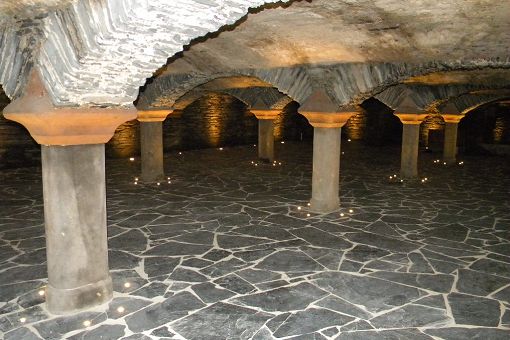
Moselschlösschen
Originally Rumpel & Cie. Winery, subsequently Franz Otto Klein, then the DSG-Mitropa cellar, now the Moselschlösschen Hotel.
The former Rumpel family dynasty played a founding role in establishing Traben-Trarbach’s emergent wine trade. Records of their prudent business dealings exist from as far back as the eighteenth century.
Starting point and centrepiece of the cellar ensemble is the Pillar Cellar ("Säulenkeller") dating from 1754. It has been sensitively restored within monument preservation guidelines and freed from any later additions. These days, enhanced by some tastefully aesthetic lighting, it represents a true gem of secular wine cellar architecture. The square site features eight oval basalt pillars with sandstone capitals. Ribs made of slate rubble fan out from the capitals to meet the vertical side walls. Between the ribs, flat vaults form the cellar ceiling. A well bored into the slate bedrock on the hill side of the cellar provides a constant supply of clear water.
On the Mosel side the ensemble features six small interconnecting cellars, in places still paved with round Mosel pebbles (known as "Katzenköpp"), which lead to an exit beneath the commanding officer’s quarters in the former fort Mont-Roýal. Passing a small relief of the Traben coat-of-arms with its steed and the year 1754 you follow a connecting passage to reach a spacious cellar with a groined vault dating from 1901.
The symmetrically designed cellar, today used as underground parking, features four aisles and eight transepts. Owing to the concrete tank lined with glass tiles located on the west side, it had a huge storage capacity, hence its function as main cellar for many decades under the ownership of both the Mitropa and DSG respectively. A barrel handlers’ tunnel led to the Mosel to ease the loading of wine barrels onto ships.
No doubt this latter consideration also played a role in the purchase of the dynasty’s prestigious family residence which dominated Traben’s riverside promenade. A few smaller vintners' cellars located below and ascending on the upper side of the building were purchased to increase capacity prior to the construction of the beautiful pillared cellar, or "Säulenkeller", beneath a series of workshops and offices in 1754. The low vaulted ceiling rests on eight oval granite pillars with sandstone capitals linked to each other via ribs. At one of the end walls there is a deep well.




